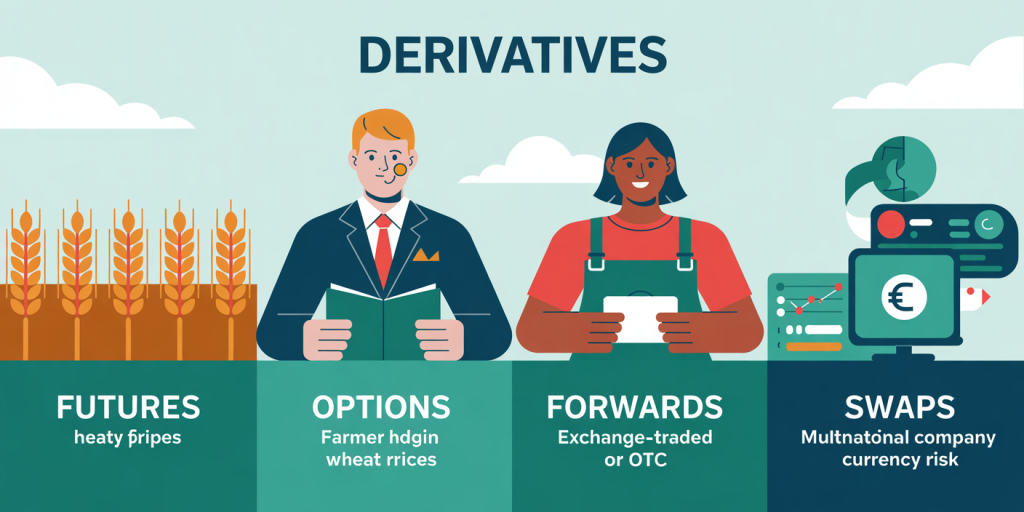Understanding Derivatives: A Beginner’s Guide
Anúncios
Derivatives are fundamental financial instruments widely used across global markets. Yet, for many beginners, the term “derivatives” remains confusing and often intimidating. This guide aims to demystify derivatives by explaining their basics, practical uses, types, and significance in modern finance. Whether you are an investor, student, or simply curious about how financial markets operate, this article will provide you with a comprehensive, easy-to-understand overview of derivatives.
In essence, derivatives derive their value from underlying assets such as stocks, bonds, commodities, interest rates, or currencies. Tracking derivatives is essential because, according to the Bank for International Settlements (BIS), the notional amount of outstanding derivatives contracts globally exceeded $610 trillion as of June 2023. This astronomical scale shows the critical role derivatives play in hedging, speculation, and risk management worldwide.

Anúncios
What Are Derivatives and How Do They Work?
Derivatives are contracts between two or more parties whose value is dependent on the performance of an underlying asset. These contracts don’t necessarily require ownership of the underlying asset; instead, they represent an agreement to buy or sell the asset in the future at predetermined conditions. This characteristic makes derivatives unique compared to direct investment in assets.
Anúncios
A practical example is a futures contract on crude oil. Imagine an airline company concerned about rising fuel prices. By purchasing oil futures, the airline can lock in a fixed price for oil at a future date, effectively hedging against price volatility. If oil prices rise, the airline benefits from the locked-in lower prices through the derivative contract. Conversely, if prices drop, the contract could lead to losses compared to the spot market. This dual possibility of gain or loss illustrates the speculative appeal of derivatives.
Derivatives work through standardized contracts traded on exchanges or customized contracts traded over the counter (OTC). The former involves regulated markets with transparent pricing, while the latter offers flexibility but may carry greater counterparty risk. Depending on the market, derivatives include features such as margin requirements, settlement procedures, and expiry dates, which affect how parties can profit or hedge risks.
Common Types of Derivatives and Their Uses
There are four primary categories of derivatives: futures, options, forwards, and swaps. Each serves different purposes and suits different types of market participants.
Futures: Futures contracts are agreements to buy or sell an asset at a predetermined price on a specific future date. They are standardized and traded on exchanges like the Chicago Mercantile Exchange (CME). Futures are widely used for commodities like oil, gold, and agricultural products, as well as financial assets like indices and currencies. For example, a farmer can sell wheat futures to lock in prices before the harvest, thus protecting against price declines.
Options: These give the holder the right, but not the obligation, to buy (call option) or sell (put option) an asset at a set price within a specific timeframe. Options enable investors to gain leverage with limited downside risk. A classical real-case involves portfolio managers buying put options to hedge against sharp market downturns, especially during volatile periods like the 2008 financial crisis.
Forwards: Forward contracts resemble futures but are privately negotiated and traded OTC. Their customization allows parties to tailor contract terms to fit specific needs. Forwards are commonly used in foreign exchange (FX) markets by multinational companies to hedge currency risk in international trade.
Swaps: Swaps are agreements to exchange cash flows or liabilities from two distinct financial instruments. Interest rate swaps are prevalent, allowing entities to convert fixed-rate debt into floating rate and vice versa. This tool is critical for managing interest rate exposure, especially for corporations and financial institutions.
| Derivative Type | Market Type | Standardization | Primary Use | Example Scenario |
|---|---|---|---|---|
| Futures | Exchange-Traded | Standardized | Hedging/Speculation | Farmer locking wheat price before harvest |
| Options | Exchange & OTC | Standardized/Custom | Leveraging/Risk Management | Portfolio manager buying puts during market downturn |
| Forwards | OTC | Customized | Currency Hedging | A multinational company fixing FX rates for future payment |
| Swaps | OTC | Customized | Interest/Commodity Risk | Corporation swapping fixed rate debt for floating rate |
Statistics from the Options Clearing Corporation (OCC) reveal that options trading volume soared over 40% in 2022 compared to the previous year, underpinning their growing popularity among both retail and institutional traders.

Why Are Derivatives Important in Financial Markets?
Derivatives serve multiple essential roles, benefiting both investors and corporations. One of the most critical functions is risk management. By allowing market participants to hedge against price fluctuations, derivatives reduce uncertainty and stabilize earnings. For example, airlines, manufacturers, and agricultural producers routinely use derivatives to protect profit margins from volatile commodity prices.
Another important role is price discovery. Derivatives markets help reveal the market consensus about future prices of underlying assets. Futures prices, for instance, embed information about expected supply and demand, interest rates, and risk premiums. This data assists producers, consumers, and policymakers in making informed economic decisions.
Derivatives also add liquidity. Large volumes of derivatives contracts translate into substantial trading activity, which enhances liquidity not only for the derivative instruments but sometimes also for the underlying assets. According to the World Federation of Exchanges, derivatives markets handle trillions of dollars daily, showing their pivotal role in global capital flows.
However, it’s important to acknowledge that derivatives carry inherent risks if misused. The 2008 financial crisis highlighted the dangers of excessive leverage and complex derivative products like credit default swaps (CDS). Post-crisis regulations increased transparency and capital requirements, but the potential for derivatives to amplify losses remains a cautionary tale.
Real-World Applications and Case Studies
Understanding derivatives through real cases sheds light on their tangible impact.
Case Study 1: Southwest Airlines and Hedging Fuel Costs
Southwest Airlines famously used futures and options in the early 2000s to lock in fuel prices successfully. At a time when oil prices skyrocketed, Southwest’s proactive derivatives strategy saved the company hundreds of millions in fuel expenses compared to competitors who paid spot prices. This strategic use of derivatives contributed to Southwest’s financial stability and competitive advantage.
Case Study 2: The 2008 Financial Crisis and Derivative Fallout
The subprime mortgage meltdown in 2007-2008 exposed significant vulnerabilities in derivatives markets, particularly in credit default swaps (CDS). Financial institutions like Lehman Brothers faced massive derivative losses due to risky derivative positions on mortgage-backed securities. The aftermath led to sweeping reforms under the Dodd-Frank Act aiming to enhance transparency and reduce systemic risks linked to OTC derivatives.
Case Study 3: Currency Forwards in Global Trade
A U.S. company importing electronics from Japan may face currency risk due to fluctuating USD/JPY exchange rates. By entering into a forward contract to buy Japanese yen at a fixed rate, the company stabilizes its import costs and guards its profit margins. This straightforward use of derivatives is a daily practice among multinational corporations to manage FX exposure.
Differentiating Derivatives from Other Financial Instruments
To fully grasp derivatives, it’s helpful to compare them to other investment vehicles:
| Aspect | Derivatives | Stocks | Bonds |
|---|---|---|---|
| Ownership | No ownership of underlying asset | Ownership stake in company | Debt obligation issued by entity |
| Purpose | Hedging, speculation, arbitrage | Capital appreciation, dividends | Income generation, capital preservation |
| Risk Profile | Can be highly leveraged, volatile | Moderate, price risk | Generally lower risk, interest rate exposure |
| Timeframe | Usually short to medium term | Long-term investment | Medium to long-term |
| Complexity | Often complex, specialized | Generally straightforward | Moderate complexity |
Investors use derivatives to complement or diversify traditional portfolios, by gaining exposure to price movements without directly buying the underlying asset. This leverage effect can both magnify returns and amplify risks, which is why proper understanding is crucial before engagement.
Emerging Trends and Future Perspectives in Derivatives Markets
Derivatives markets are continuously evolving, driven by regulatory changes, technological advances, and shifting investor preferences. One exciting trend is the rise of decentralized finance (DeFi) and blockchain technology, which is revolutionizing how derivatives are created and traded. Smart contracts on platforms like Ethereum enable automated, transparent, and tamper-proof derivative agreements without traditional intermediaries.

Moreover, environmental and socially responsible derivatives are gaining traction. Carbon credit futures and options are becoming mainstream as companies strive to manage and offset their carbon footprints, aligning with global sustainability goals outlined in agreements like the Paris Accord.
Artificial intelligence and machine learning are also beginning to influence derivatives trading by improving risk assessment, pricing models, and fraud detection. As the derivatives landscape grows more complex, these technologies offer opportunities for enhanced decision-making and market efficiency.
From a regulatory standpoint, global bodies continue to emphasize increasing transparency in OTC derivatives through centralized clearinghouses and reporting mechanisms. These measures aim to reduce systemic risk and bolster market integrity.
Looking ahead, derivatives will likely play an even more critical role in navigating economic uncertainties, climate-related risks, and digital transformations, proving indispensable to both sophisticated investors and everyday businesses.
Derivatives, while complex, offer versatile tools for risk management, speculation, and enhancing market liquidity. Understanding their types, functions, and practical applications equips market participants to harness their power responsibly. As markets evolve, staying informed about the latest trends and regulatory developments will help individuals and organizations leverage derivatives to their advantage in an increasingly interconnected world.



Post Comment